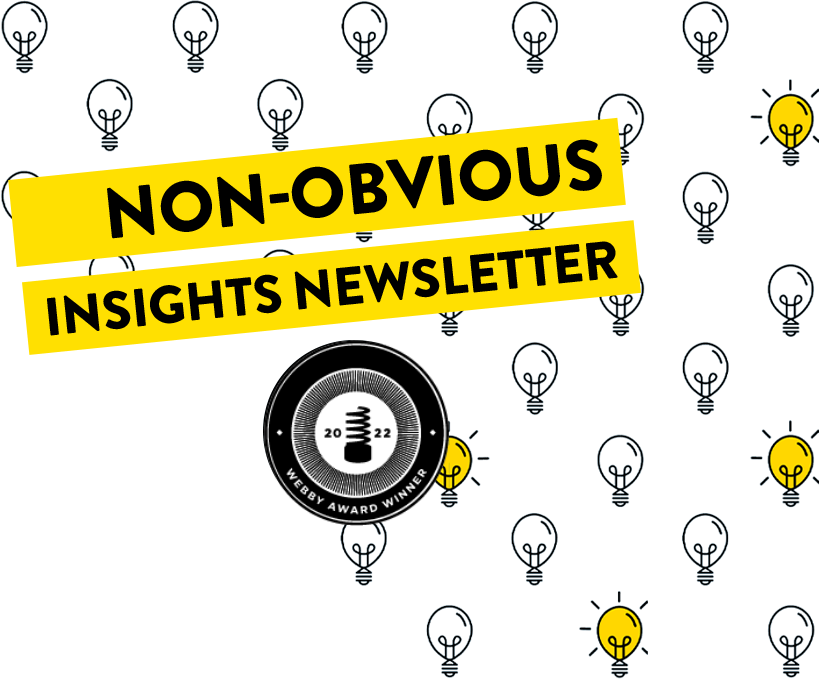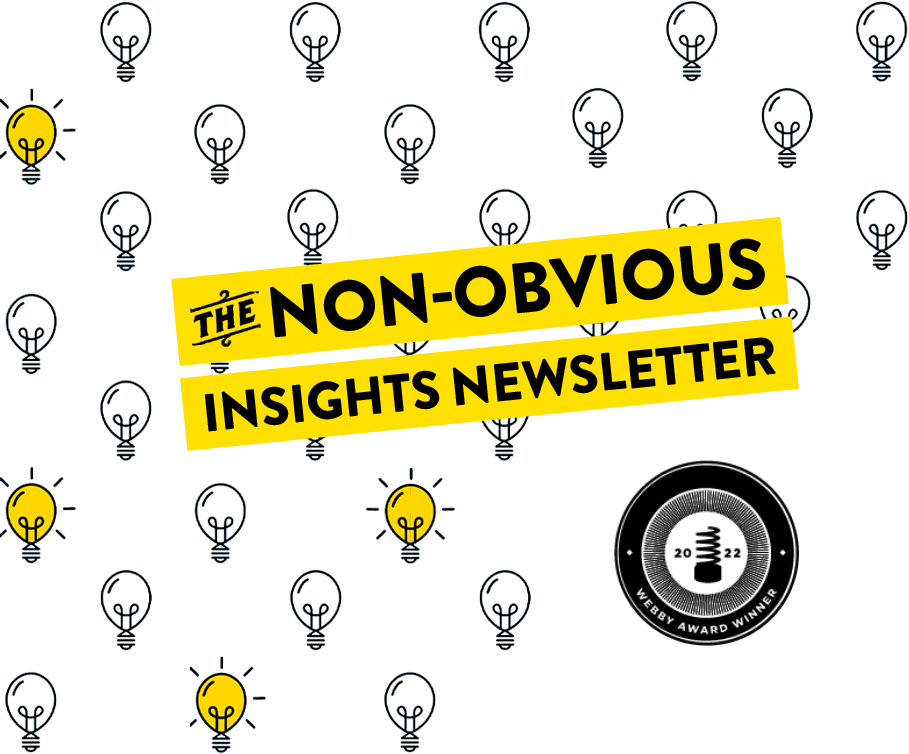Dear Fellow Trend Curator,
Are companies using “sludge” — deliberate customer service obstacles — to avoid angry customers? Could the shift toward smaller, independent agencies be a bright spot in a struggling industry? Did Carnival Cruise just launch a case study in destroying brand loyalty? These questions will all be answered in this week’s newsletter. In other stories, we’ll look at why Copenhagen’s adult-only park is sparking fresh urban planning ideas and showcase a book that explains exactly how every generation thinks and what you need to know about the generational cohort you’re part of … and all the others too!
Enjoy the stories and stay curious!
Is “Sludge” a Real Customer Service Tactic to Avoid Irate Customers?
There is a term in Cass R. Sunstein and Richard H. Thaler’s book Nudge, first published in 2008, that introduces the idea of sludge–“tortuous administrative demands, endless wait times, and excessive procedural fuss that impede us in our lives.”
“In 2023 (the most recent year for which data are available), the National Customer Rage Survey showed that American consumers were, well, full of rage. The percentage seeking revenge—revenge!—for their hassles had tripled in just three years … Researchers have shown how “sludge” leads people to forgo essential benefits and quietly accept outcomes they never would have otherwise chosen.”
According to new emerging research, this problem of sludge affects everything from warranty service requests to denied medical insurance claims. Rather than being an outlier, a recent article from The Atlantic explains how many customer service agents are trained to create sludge. Here’s a description of the practice, in the words of one former agent interviewed for the article:
“They would outright tell you in training you’re not allowed to give them a rebate offer unless they ask you about it with specific words,” she said. “If they say they’re paying too much money, you couldn’t mention the rebate. Or if the customer was asking about a higher rebate but you knew there was a lower one, they trained us to redirect them to that one.” … “They’d call me in constantly to retrain me,” she said. “I wasn’t meeting the numbers they were asking me to meet, so they weren’t meeting their numbers.” Supervisors didn’t tell Harris to deceive or thwart customers. But having them get frustrated and give up was the best way to meet those numbers.”
Forecasting to the future, experts predict this problem is likely to get even worse as more of these customer service calls get handled by automation and AI technology. So how can any of us fight back against sludge? Persistence. Being the “squeaky wheel.” Escalating through any means possible. Or eventually … giving up and just moving on.
Why Big Company Life Feels Broken … and Why Smaller Players May Win
When ADWEEK conducted a recent survey on the current mood at ad agencies owned by the major holding companies, the results were predictably depressing. The short conclusion: “Morale is low, job insecurity is high, and many ad agency employees are looking to leave the entire industry.” The reasons for this are pretty obvious. Overall jobs are down by about 4% in the past two years. Layoffs, industry consolidation and the impact of AI on jobs have been extremely disruptive. Buried in the survey, though, was an interesting glimmer of hope for the industry:
“Data from the survey [also] shows employees at independent ad agencies are doing better than their holding company peers. Morale is high. Job insecurity is low. Hope is alive.”
One path I never took when leaving the big agency world (but many of my friends and peers did), was going independent either by starting their own agency or joining a smaller agency. As disruption continues to affect the biggest players in the industry, the appeal for talent and clients alike to go with smaller agencies may continue to rise.
While this survey focuses just on one industry, I suspect this shift may be affecting other industries from consulting companies to law firms as well. I’m curious to test that theory, though. If you’re in a services business, is the shift from large firms to smaller ones something you’re experiencing in your industry?
How Carnival Cruise Killed Their Loyalty Program … And What Happens Next
In mid-June, Carnival Cruise Lines launched what may be the most shocking (and potentially destructive) experiment in the history of loyalty programs. They essentially announced that they will be scrapping their 13-year old program and instead replacing it with a new system based on how much you spend. More specifically, they are taking away Lifetime Diamond Membership for customers and instead requiring people to requalify for it with ongoing spending on new cruises. For the past few weeks, brand loyalists and fans are actively sharing videos about how much they hate it, calling the new program a “glorified credit card rebate program.”
Why is this so potentially damaging for the brand? Here’s an excellent breakdown from neuromarketing expert Roger Dooley in his analysis of the program changes for Forbes:
Here’s what Carnival got wrong from a behavioral standpoint: they’re taking away something customers already own. Under the old system, a cruiser who sailed frequently over many years earned lifetime Diamond status based on nights at sea. That status felt earned, permanent, and emotionally valuable. Behavioral economists call this the “endowment effect”—once we own something, losing it feels much worse than never having it at all. Now Carnival is essentially telling these customers: “Thanks for your loyalty, but you need to pay up or lose what you’ve earned.” This fundamentally changes who can be “loyal” to Carnival. Frequency and long-term engagement no longer matter. It’s all about 24-month spend.
It is possible this could be a sneaky tactic to stoke some short-term outrage from their best customers before reversing course and giving back these earned lifetime status privileges. And if so, that could work. Time will tell. If not, this could become a case study taught in business schools for how to destroy brand loyalty overnight.
Copenhagen’s Adult Park Offers Rare Child-Free Green Spaces
On UNICEF’s latest list of the best countries for children, Denmark came in second place. Copenhagen as a city is known for being kid-friendly, scoring high on something called the “popsicle test”–which assesses the safety of a place “according to whether an eight-year-old can walk to a shop on their own, buy a lolly and return home safely.” It’s a unique way to measure safety but does offer some insight into what has typically been most important for urban planners when designing public spaces in Denmark.
The downside, according to an article from Copenhagen based writer Michael Booth, is that the utility of many public spaces across the Danish capital might be overly kid-friendly in a way that diminishes their value for adults:
Perhaps the adults have gone along with it because we ourselves have become so infantilised … Copenhagen’s Opera Park offers a compelling alternative approach to urban spaces, with fewer swings and rubberised safety surfaces, and more contemplative oases – quiet corners of the city in which to read a book or flirt. Who knows? If we show our children more mature ways in which to live in the city, we might begin to raise more robust grown-ups.
The idea of prioritizing adults rather than kids when designing some of these spaces is the interesting non-obvious suggestion Booth proposes in his article. For a place like Copenhagen, and perhaps many others around the world, the broader idea is that the design of these spaces could empower more adults to connect with one another … which should be just as much a priority as keeping kids safe, active and entertained.
The Non-Obvious Media Recommendation of the Week
Rest of World
Like the title of this site suggests, the primary goal is to offer a perspective that centers experiences, stories and innovations from those outside the usual Western nations:
Rest of World is a nonprofit publication that challenges expectations about whose experiences with technology matter.
We like the term [“Rest of World”] because it encapsulates the problems we fight head-on: a casual disregard for billions of people, and a Western-centric worldview that leaves an unthinkable number of insights, opportunities, and nuances out of the global conversation. Our vision is to become an indispensable source of information that captures people’s experiences with technology outside the West producing stories that connect the dots, empower local journalists, hold the powerful accountable, and challenge stereotypes.
From a retrospective on the rise of Skype to the “spectacular crash” of India’s largest EV company, the stories from Rest of World are often the ones you won’t find covered in any Western media. As a result, it’s a great news source to add to your reading list to broaden your perspective … and my pick to recommend for the Non-Obvious Media Platform of the Week.
The Non-Obvious Book of the Week
Generations by Jean M. Twenge
If there was ever a book that could demystify and explain the differences between these generational labels we assign to one another, this is it. Legendary psychology professor and generational expert Jean M. Twenge explains it all in this 500+ page compendium of everything you ever heard (or were misled by) about the differences between Gen Z, Millennials, Gen X, Boomers and the Silent Generation.
While these terms may mean something different to all of us, the big idea of this book is that the mindset of every generation is shaped not by the wars or geopolitical shifts of their formative eras, but by the technologies of those times. Though long, this book is logically divided by generation so you can easily flip to the insights about yours first and then move to the others. For anyone looking to better understand how culture and psychology of generations gets shaped–and what it means, this book is the perfect guide.
About the Non-Obvious Book Selection of the Week:
Every week I share a new “non-obvious” book selection. Titles featured here may be new or classic books, but the date of publication doesn’t really matter. My goal is to elevate great reads that perhaps deserve a second look which you might have otherwise missed.
Even More Non-Obvious Stories …
Every week I always curate more stories than I’m able to explore in detail. Instead of skipping those stories, I started to share them in this section so you can skim the headlines and click on any that spark your interest:
- Just in Time for Summer Wedding Season, Coors Light Introduces the Cold Tux to Keep You (and Your Beer) Nice and Cool
- Canada’s Archives Are in Trouble—and So Is Its History
- Authors Petition Publishers to Curtail Their Use of AI
- 5 Marketing Truths You Won’t Hear at Cannes
- How SFGate Is Making Local News Work (And Surviving)
- Newark’s Air Traffic Outages Were Just the Tip of the Iceberg
How are these stories curated?
Every week I spend hours going through hundreds of stories in order to curate this email. Looking for a speaker to inspire your team to become non-obvious thinkers through a keynote or workshop?
Watch my 2024 speaking reel on YouTube >>
This Non-Obvious Insights Newsletter is curated by Rohit Bhargava. Copyright © 2024 Non-Obvious, All rights reserved





